This Baklava Cheesecake is a stunning holiday showstopper. Crisp, golden phyllo wraps around a creamy orange-scented ricotta cheesecake, finished with a drizzle of honey and a sprinkle of pistachios.
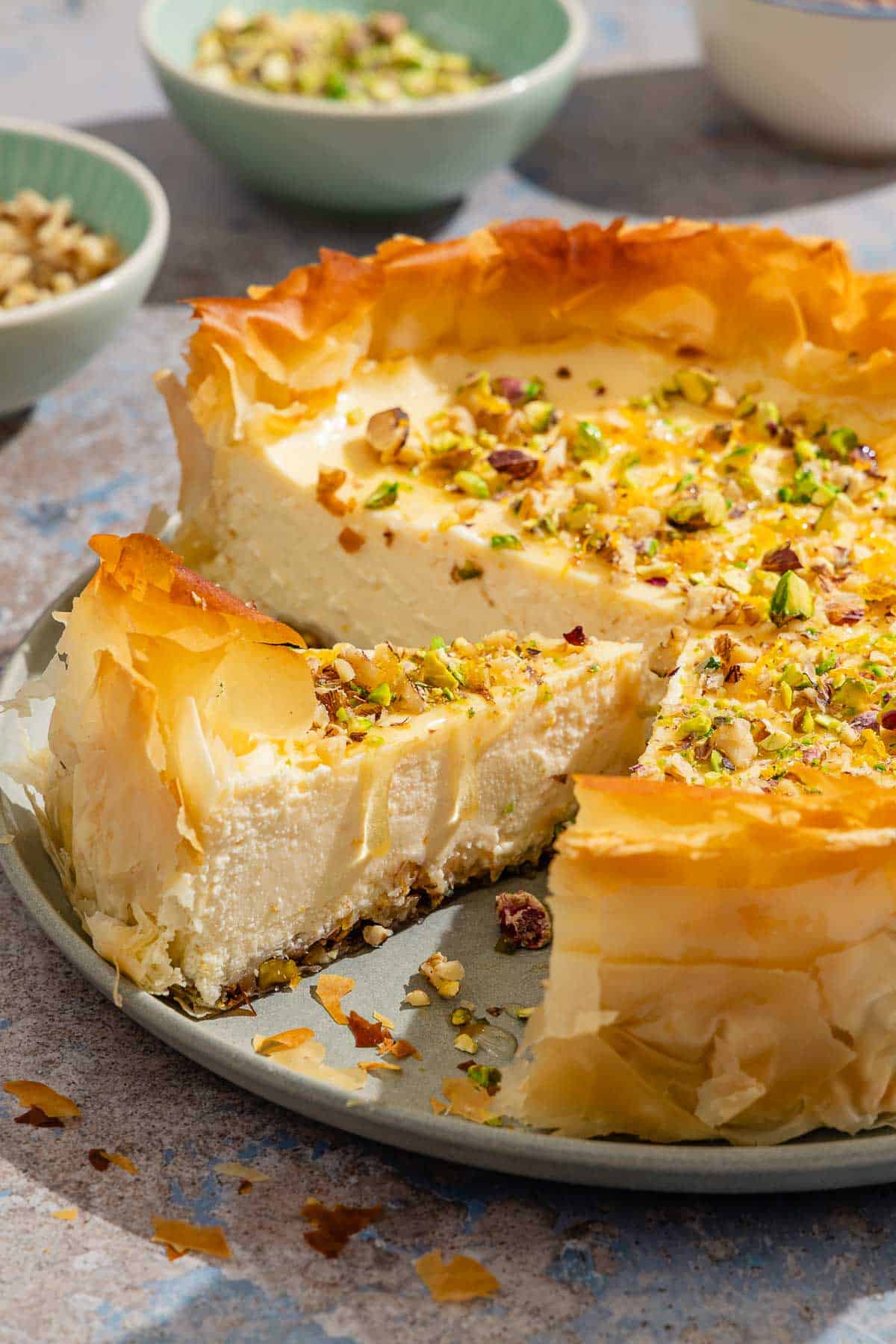
This baklava cheesecake recipe fits into the holy trifecta of dessert categories: tastes incredible, looks fancy, but is secretly simple to make!
Store bought phyllo dough is easier to manage than it seems. You get the most beautiful crispy and light crust with no kneading or rolling required. I also kept the filling easy by swapping lemon for orange in my 5-ingredient Italian Ricotta Cheesecake. You just don’t mess with a great recipe that gives you an indulgent yet airy cheesecake! Plus, you don’t even need a water bath or fancy techniques!
When you grow up eating baklava at every family gathering like I did, you have some strong opinions about what makes the best one. This simple recipe celebrates that tradition and those flavors, with my own modern twist. It’s the exact type of recipe I’ve loved creating since I started The Mediterranean Dish. I hope you enjoy it as much as I do!
Table of Contents
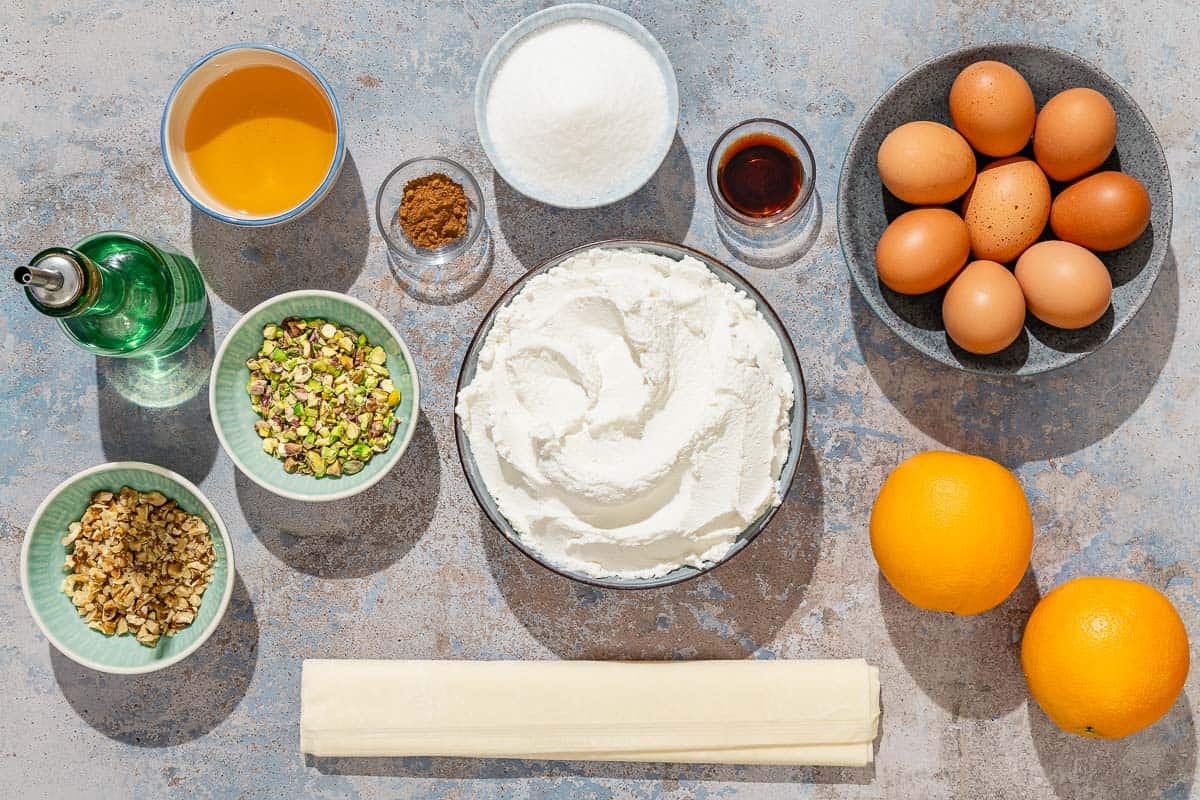
Ingredients and Substitutions
Though this recipe has big Mediterranean flavor, it’s made of easy to find ingredients. You’ll need:
- Olive oil: Use a high quality extra virgin variety with a smooth, buttery flavor, like our Italian Nocellara.
- Nuts: I love combining crunchy walnuts and tender pistachios, but you can use one or the other.
- Sugar: A touch of sugar sweetens the nut mixture and ricotta filling.
- Ground cinnamon: Brings the warming baklava flavor. Allspice can also work in a pinch.
- Phyllo dough: These thin sheets of unleavened pastry are most often found in the freezer aisle. Simply thaw in your fridge overnight.
- Ricotta: Homemade ricotta is a special treat, but store-bought whole milk ricotta also works well.
- Eggs: Add structure and richness to the filling.
- Vanilla extract: Adds depth of flavor. You can also use the scraped seeds of a vanilla pod, if you don’t mind the splurge!
- Oranges: Opt for untreated oranges, as you’ll use the zest. Lemon zest works as a substitute.
- Honey: I love the savory herbal notes of our Greek Alfa honey with this recipe, but any light and delicate honey you love will be delicious.
How to Make Baklava Cheesecake
Cheesecake does best when it sits in the fridge for 24 hours before serving, which makes it a perfect make ahead dessert.
- Get ready. Position a rack in the middle of your oven and heat to 350°F. Brush a 10-inch springform cake pan with olive oil, then set on a large sheet pan.
- Make the nut mixture: Chop 1/3 cup walnuts and 1/3 cup pistachios. Transfer to a small bowl with 2 tablespoons sugar, and 1 teaspoon cinnamon. Toss, then set aside for now.
- Assemble the phyllo crust: Lay two sheets of phyllo in the oiled springform pan and press gently onto the bottom and sides. Brush the phyllo with olive oil, including any parts hanging over the pan. Lay another 3 sheets of phyllo on top so they overlap, rotating the pan so that the phyllo will cover it on all sides (there should be phyllo slack hanging over on all sides of the pan).
- Layer on the nut mixture: Brush with olive oil, then sprinkle the nut mixture over the phyllo to cover the bottom of the pan.
- Finish the crust: Place the remaining phyllo sheets over the nut mixture, following the same pattern and making sure to brush each sheet of phyllo with olive oil. (If the overlay of phyllo dough is too long, you can fold it over or cut it with a pair of kitchen scissors).
- Prepare the cheesecake batter: To the bowl of a standing mixer fitted with a paddle attachment, add 3 pounds whole milk ricotta cheese (strain first), 8 large eggs, 1 1/4 cups sugar, 1 teaspoon vanilla extract, and zest of one orange. Start the mixer on low for 1 to 2 minutes, then increase the speed to medium-low (2 on the KitchenAid mixer) for 10 minutes. The mixture will look light and fluffy. (If using a hand-mixer, keep the speed low. If using a wooden spoon, mix continuously until fluffy.) Pour the batter into the prepared pan with the phyllo.
- Bake the cheesecake: Place the cheesecake in a preheated oven for one to 1 1/2 hours, or until the batter has mostly firmed up and the top of the cake and phyllo crust has gained a nice golden brown color. The batter may still jiggle slightly in the middle, but it will firm up once cooled. (Keep an eye on the phyllo crust–if it is turning too brown too quickly, adjust the heat to 325°F.)
- Cool: Remove from the oven and place on a wire rack to cool for 1 to 2 hours. Transfer to the fridge for at least 6 hours, or overnight.
- Finish and serve: Put 1/4 to 1/3 cup honey in a glass bowl set inside a bowl of warm water to gently warm. Let it sit for 5-10 minutes, stirring occasionally until it loosens and becomes pourable. Break off any extra phyllo crust hanging over the sides of the cheesecake that could make it difficult to release. (You can crumble the crust and add it on top to garnish). Release the lever on the side of the pan, remove the cake and transfer to a platter. Garnish with more chopped nuts and the zest of 1 orange, then drizzle with the warmed honey. Enjoy!
Tips for Cheesecake Success
This ricotta filling is very beginner-friendly—no complicated steps or water bath required. Here are a few easy pointers will make this baklava cheesecake recipe a new favorite:
- Fully drain the ricotta: For best results, press through a cheesecloth-lined strainer. If your ricotta seems super watery, set the strainer over a bowl and let it drain overnight in the fridge. This prevents a watery cheesecake.
- Use room temp ingredients: Bring your (strained) ricotta and eggs to room temperature before making the filling. Cold ingredients can result in a lumpy batter.
- Mix the batter slowly: Overworking the ricotta can break down its curds, leading to a rubbery texture once baked.
- No peeking: Give your cheesecake at least an hour in the oven before checking for doneness. This ensures your oven stays hot and you get a nice rise.
- Double cool: Letting the cheesecake rest on the counter for 1–2 hours is an important part of the setting process! Once it’s cool, chilling in the fridge (ideally overnight) will allow it to fully set.
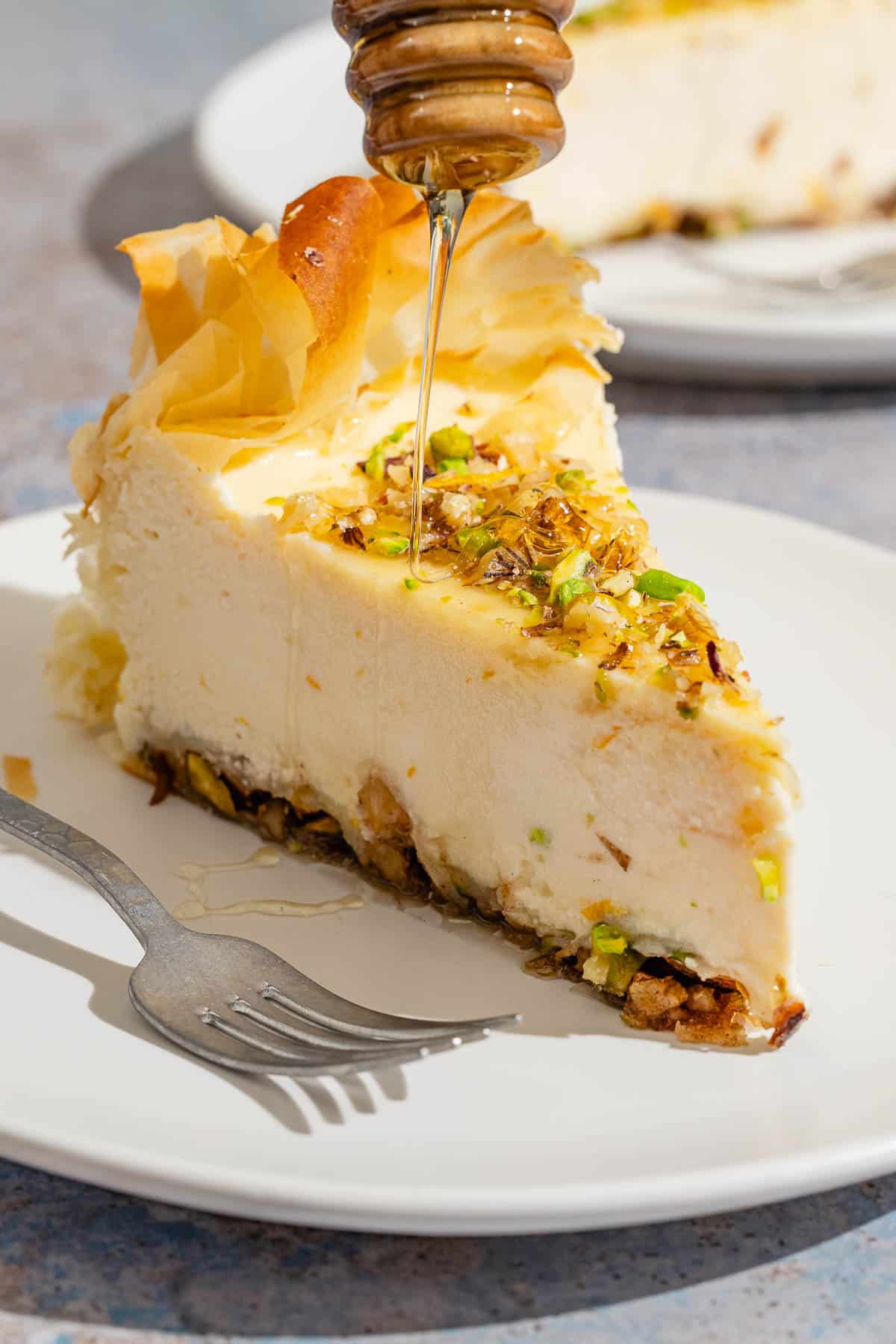
Tips for Working with Phyllo Dough
This recipe is very forgiving–your phyllo can rip and there will be another layer ready to step up. But here are some phyllo dough best practices, whether you’re making baklava cheesecake, spanakopita, and beyond:
- Defrost fully: Place the unwrapped dough in the fridge for at least 8 hours, or overnight. If it still feels slightly frozen, allow it to sit at room temperature for an hour before using.
- Brush liberally: Because phyllo dough is so paper-thin, it can get brittle very quickly. Brushing phyllo with fat (typically olive oil or melted butter) keeps it supple and helps it bake up golden brown and crispy.
- Keep it covered: When left exposed to the air for too long, phyllo will become dry and can shatter into one million frustrating little pieces. A clean, slightly damp kitchen towel works best to keep the phyllo dough pliable while you’re assembling the crust.
More Baklava and Cheesecake Recipes
Browse all Mediterranean recipes.
Visit Our Shop.
Baklava Cheesecake
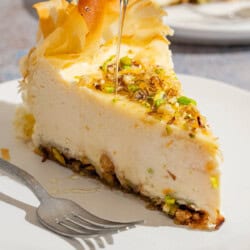
Ingredients
For the Phyllo Crust
- Extra virgin olive oil
- 1/3 cup walnuts, chopped, plus more chopped walnuts for garnish
- 1/3 cup pistachios, chopped, plus more chopped pistachios for garnish
- 2 tablespoons sugar
- 1 teaspoon ground cinnamon
- 10 sheets phyllo dough, thawed if frozen
For the Cheesecake
- 3 pounds whole milk ricotta cheese, strained and room temperature
- 8 large eggs, at room temperature
- 1 1/4 cups sugar
- 1 teaspoon vanilla extract
- 2 large oranges, zested (divided)
- 1/4 to 1/3 cup honey
Instructions
- Get ready. Position a rack in the middle of your oven and heat to 350°F. Brush a 10-inch springform cake pan with olive oil, then set on a large sheet pan.
- Make the nut mixture: In a small bowl, mix together the walnuts, pistachios, sugar, and cinnamon. Set aside for now.
- Assemble the phyllo crust: Lay two sheets of phyllo in the oiled springform pan and press gently onto the bottom and sides. Brush the phyllo with olive oil, including any parts hanging over the pan. Lay another 3 sheets of phyllo on top so they overlap, rotating the pan so that the phyllo will cover it on all sides (there should be phyllo slack hanging over on all sides of the pan). Brush with olive oil, then sprinkle the nut mixture over the phyllo to cover the bottom of the pan. Place the remaining phyllo sheets over the nut mixture, following the same pattern and making sure to brush each sheet of phyllo with olive oil. (If the overlay of phyllo dough is too long, you can fold it over or cut it with a pair of kitchen scissors).
- Prepare the cheesecake batter: To the bowl of a standing mixer fitted with a paddle attachment, add ricotta, eggs, sugar, vanilla extract, and half of the orange zest. Start the mixer on low for 1 to 2 minutes, then increase the speed to medium-low (2 on the KitchenAid mixer) for 10 minutes. The mixture will look light and fluffy. (If using a hand-mixer, keep the speed low. If using a wooden spoon, mix continuously until fluffy.)
- Assemble and bake the baklava cheesecake: Pour the batter into the prepared pan with the phyllo. Place the cheesecake in a preheated oven for one to 1 1/2 hours, or until the batter has mostly firmed up and the top of the cake and phyllo crust has gained a nice golden brown color. The batter may still jiggle slightly in the middle, but it will firm up once cooled. (Keep an eye on the phyllo crust–if it is turning too brown too quickly, adjust the heat to 325°F.)
- Cool: Remove from the oven and place on a wire rack to cool for 1 to 2 hours. Transfer to the fridge for at least 6 hours, or overnight.
- Finish and serve: Put the honey in a glass bowl set inside a bowl of warm water to gently warm. Let it sit for 5-10 minutes, stirring occasionally until it loosens and becomes pourable. Break off any extra phyllo crust hanging over the sides of the cheesecake that could make it difficult to release. (You can crumble the crust and add it on top to garnish). Release the lever on the side of the pan, remove the cake and transfer to a platter. Garnish with more chopped nuts and the remaining orange zest, then drizzle with the warmed honey. Enjoy!
Video
Notes
- Shop this recipe: Visit our shop to browse quality Mediterranean ingredients, including the olive oil used in this recipe.
- To defrost frozen phyllo dough: Place in the fridge (still wrapped in its package) for at least 8 hours, or overnight. If it still feels slightly frozen, allow it to sit at room temperature for an hour before using.
- To freeze:
-
- Portion the cheesecake into slices.
- Wrap each slice tightly in plastic and then cover with a layer of foil.
- To defrost, place the slice in the fridge for 5-6 hours.
- Frozen baklava cheesecake will last up to 2 months in the freezer. Keep in mind that, while delicious, the phyllo crust will not be as crispy.
Nutrition
Try Our Authentic Greek Honey!
This award-winning honey from the Fragiadakis family in Crete is sustainably harvested from the island’s bio-diverse mountains, where bees feast on wild aromatic herbs.
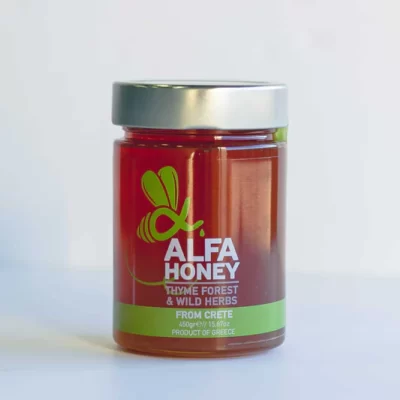
*This post has recently been updated with new information for the readers’ benefit.
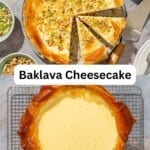
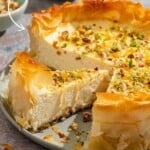
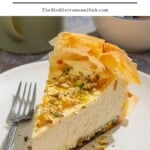
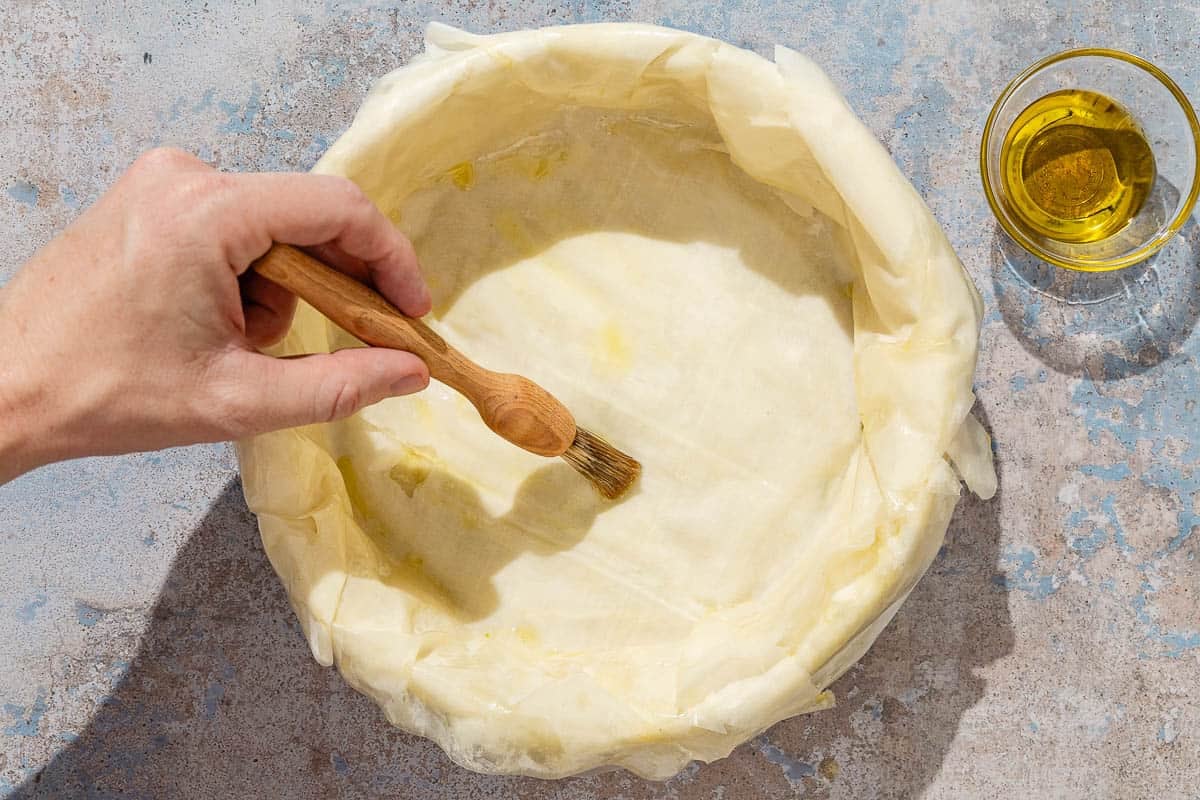
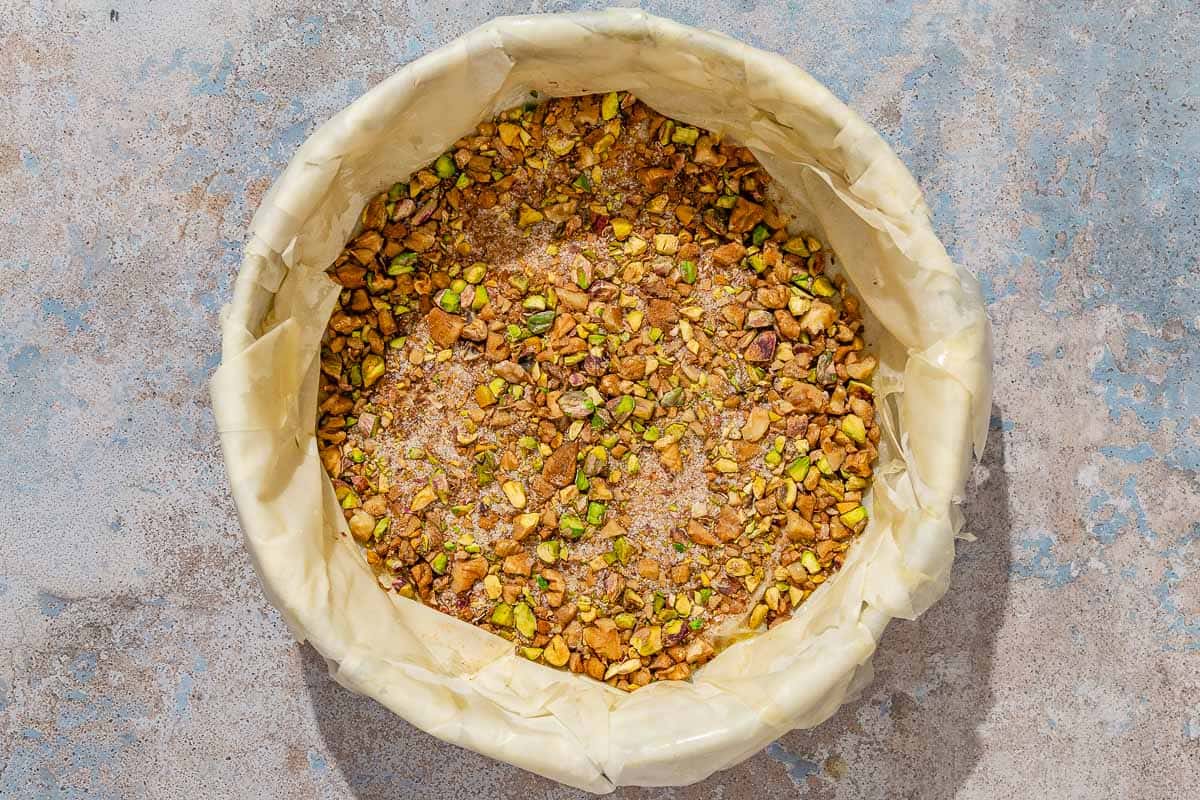
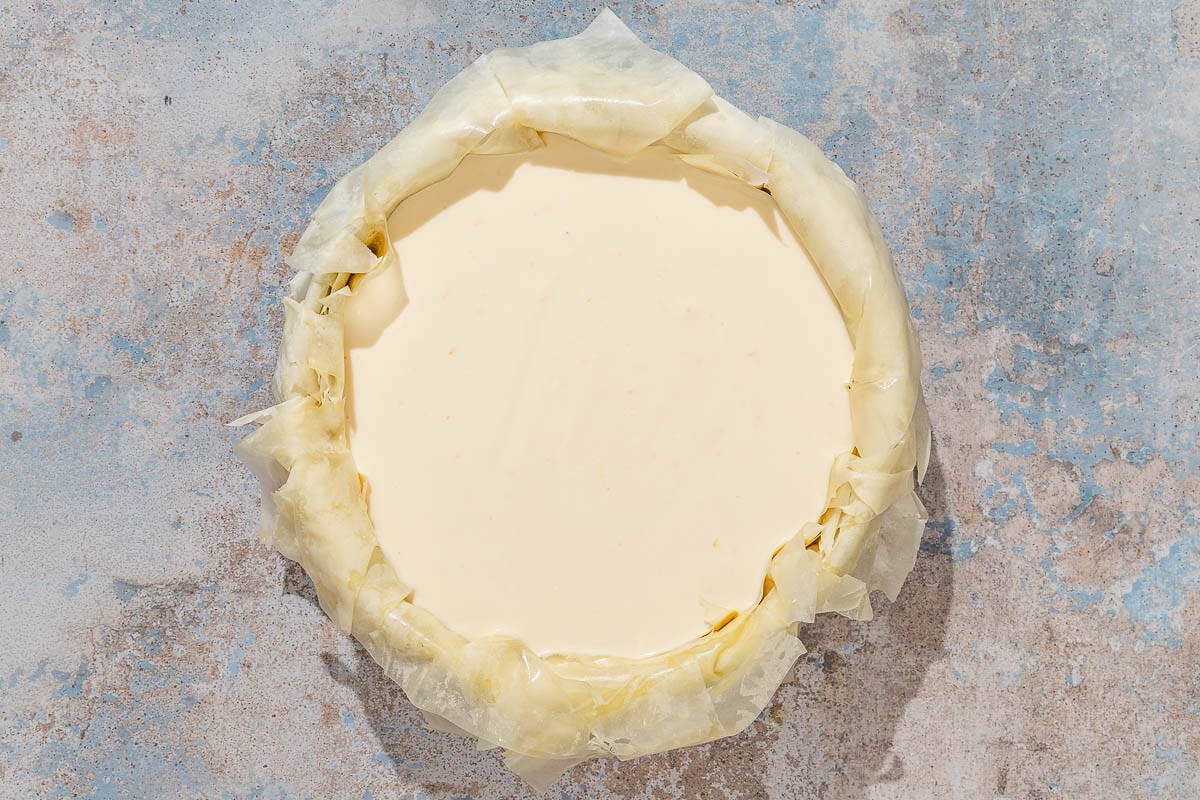
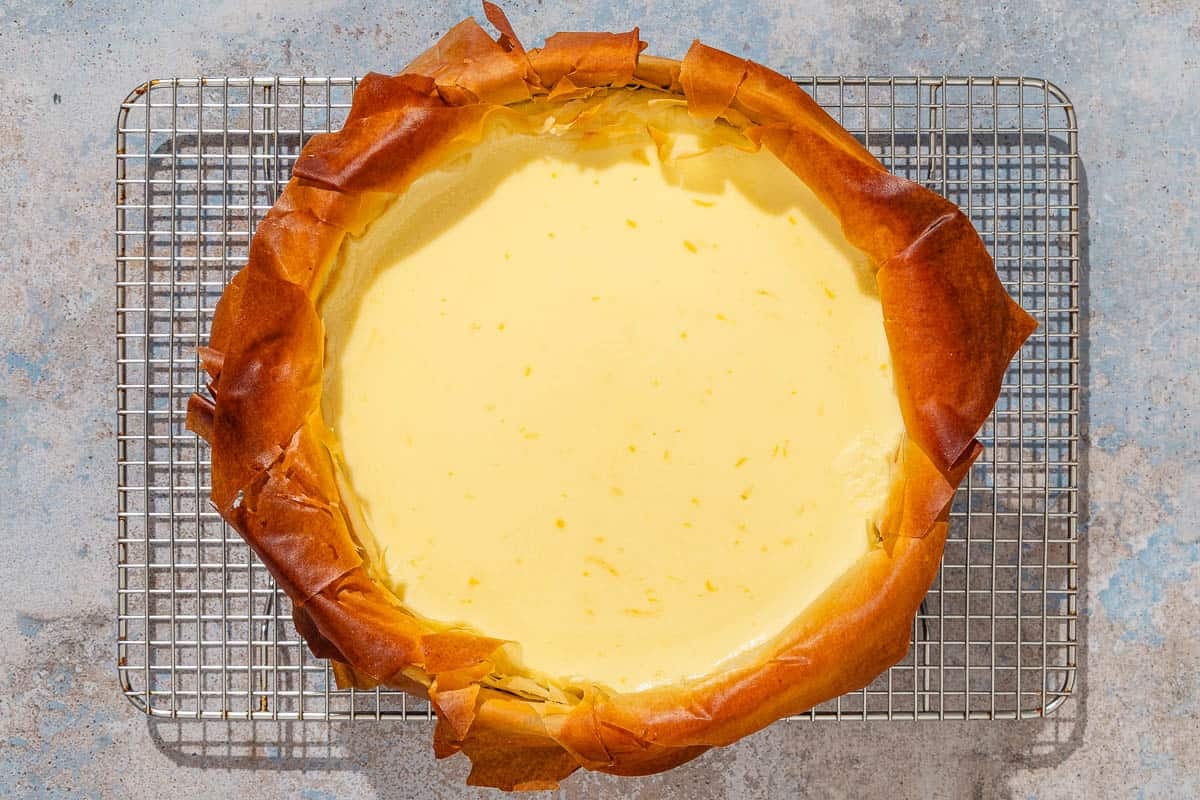
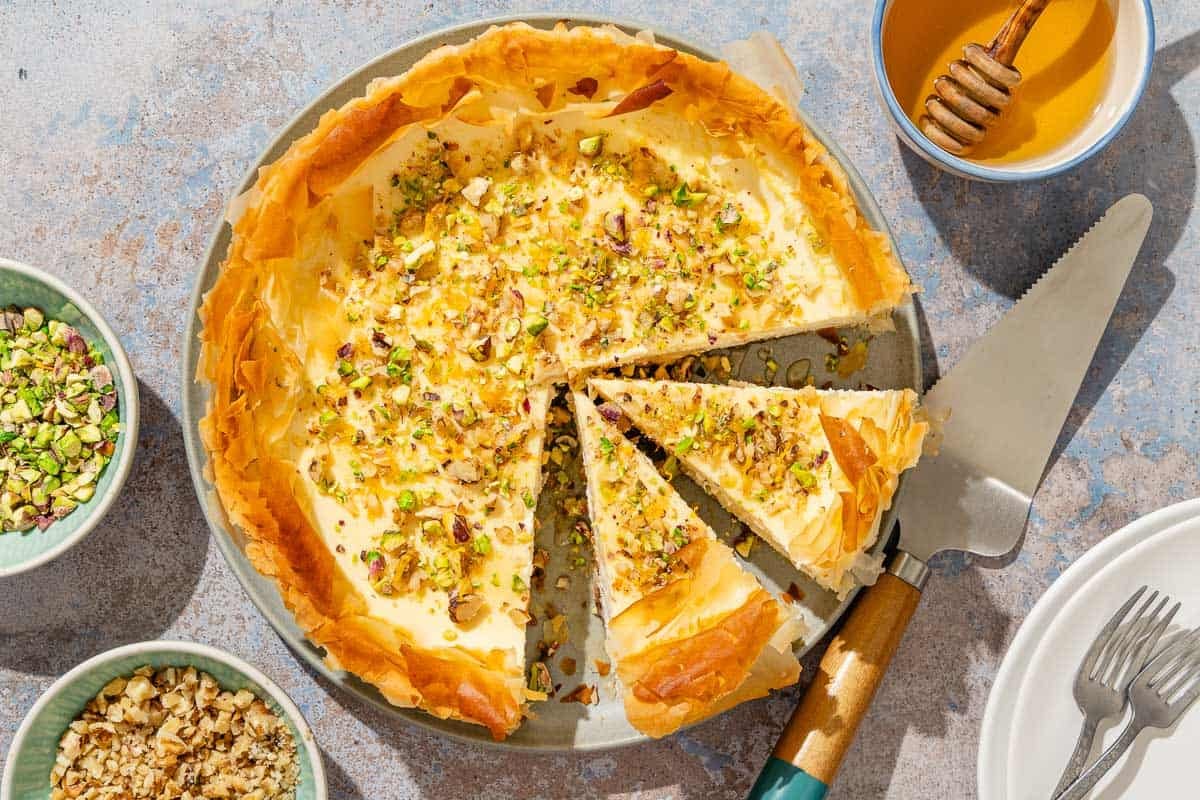
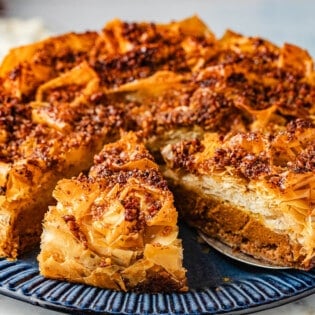
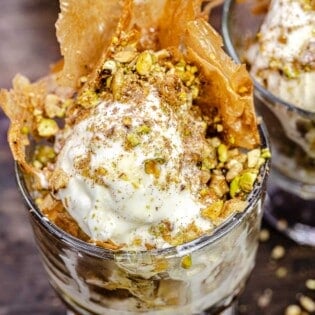
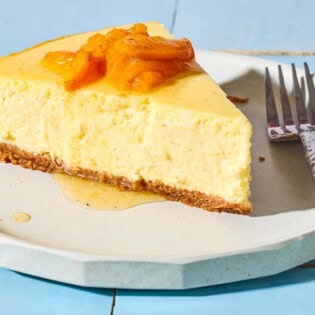
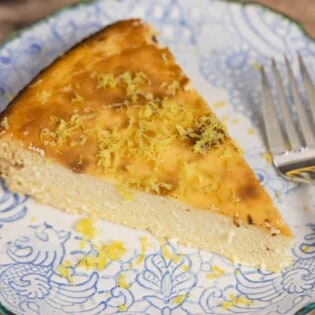
Love all your recipes that I’ve tried……and that’s a lot since I have one of the cookbooks too!
I’m wondering if this can be made with low-fat ricotta cheese? I thought if not, perhaps I could reduce the cheese and sub with some low fat Greek yogurt.
What do you think?
Hi, Eva. We’ve never tested it this way, but it might work. If you want to give low-fat ricotta a try, be sure to drain it very well, since low-fat ricotta holds more moisture and can make the filling looser. The cheesecake may be slightly less rich and creamy, but the flavor shouldn’t really be affected.
I have not made this yet, but I can tell from the recipe that it will be fabulous. I am having some friends over for lunch and am doing a Mediterranean theme.
Aperol Spritz
Mediterranean-Inspired
7-layer dip with Pita chips
Lemon-Herb Mediterranean
Chicken Salad
Baklava Cheesecake
Sounds like a delicious menu, Marita! You have some very lucky friends :).
Looks very appetizing
I would love a printable version , sounds delish!
Hi, Bey! If you tap the “Print” button right under the recipe’s title, you’ll get a great 1-2 page version of the recipe for your printer.
This looks incredible! I plan to make it for a dinner party. Would you clarify how to get the cake out of the pan? Do you tu n it upside down then flip it right side up? Would it wo k to line the pan with parchment paper?
Cheesecake is made in a springform pan. You simply remove the cake pan side by releasing the latch and the bottom of the pan remains in place. It is noted in Step 7.
Can’t wait to make this. I have Suzy’s cookbooks and they are amazing. There are so many great recipes and try one once a week. This cake will be on our Easter menu this year.
Hi, Rochelle! You will not be disappointed. I brought it to Thanksgiving and everyone raved about it. I will be making it for Easter too!
I’m impressed. Will try it out.